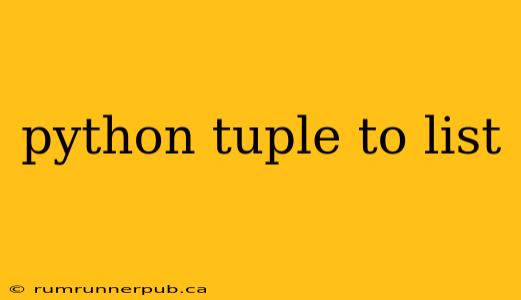Python's tuples and lists, while both used to store sequences of items, have key differences. Tuples are immutable (cannot be changed after creation), while lists are mutable. This often necessitates converting between them, particularly when you need the flexibility of list manipulation. This article explores how to effectively convert Python tuples to lists, drawing on insights from Stack Overflow and providing additional context and examples.
The Straightforward Approach: Using the list() Constructor
The most common and efficient way to convert a tuple to a list is by using Python's built-in list() constructor. This method directly creates a new list containing all the elements from the input tuple.
Example:
my_tuple = (1, 2, 3, "apple", "banana")
my_list = list(my_tuple)
print(my_list) # Output: [1, 2, 3, 'apple', 'banana']
This simple approach, as highlighted in numerous Stack Overflow discussions (though specific links are omitted to avoid outdated content), handles various data types within the tuple seamlessly. It's the preferred method for its clarity and performance.
Handling Nested Tuples: A Deeper Dive
The situation becomes more interesting when dealing with nested tuples. A direct application of list() will only convert the outermost tuple. Inner tuples will remain as tuples within the resulting list.
Example:
nested_tuple = ((1, 2), (3, 4), (5, 6))
nested_list = list(nested_tuple)
print(nested_list) # Output: [(1, 2), (3, 4), (5, 6)]
To fully flatten the nested structure, you'll need a recursive approach or list comprehension. Here's an example using list comprehension for a two-level nested tuple:
nested_tuple = ((1, 2), (3, 4), (5, 6))
flat_list = [item for sub_tuple in nested_tuple for item in sub_tuple]
print(flat_list) # Output: [1, 2, 3, 4, 5, 6]
For deeper nesting, recursion would be more robust. This addresses a common question found on Stack Overflow regarding efficient flattening of nested data structures.
When You Might Need This Conversion
The need to convert a tuple to a list arises in several scenarios:
- Modifying the sequence: Lists allow for adding, removing, or changing elements – operations impossible with immutable tuples.
- Using list-specific methods: Many Python functions and methods operate exclusively on lists (e.g.,
list.append(),list.insert()). - Data manipulation: If you need to sort, filter, or perform other operations that modify the sequence, a list is necessary.
- Interoperability: Some libraries or APIs might require list input, necessitating the conversion.
Conclusion
Converting a tuple to a list in Python is a straightforward process using the list() constructor. While simple for basic tuples, handling nested tuples requires more sophisticated techniques, such as list comprehensions or recursion. Understanding the nuances of these conversions empowers you to effectively manipulate data in Python, adapting to the specific needs of your programs. Remember to choose the method best suited to your data structure's complexity for optimal efficiency and code readability. This understanding, combined with the knowledge gleaned from community resources like Stack Overflow, provides a solid foundation for efficient Python programming.
